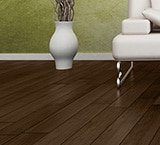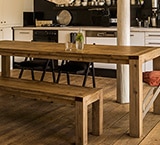Steam cleaning hardwood floors puts the oomph back into tired, grimy flooring. Over time, traditional cleaning methods of sweeping, vacuuming and mopping can't keep up with the buildup of dirt you may naturally track in every day. Mopping, in particular, is no match for the bacteria that sometimes saturates into the floors. Steam cleaning can get this deep grime and dirt, reduce allergens and keep your floors sparkling.
PREPARATION AND USAGE
You'll need only a few tools to steam clean your floors, and the first is the steam cleaner itself — you can rent or purchase one. You'll also need a dust mop or vacuum, a towel and water. Some steam cleaner manufacturers recommend using distilled water, although others require that you attach a mop to the end of the steam cleaner. Always follow their recommendation.
Before you start, clear the floors of the room(s) in which you'll work, removing anything that might get in the way: rugs, plants or furniture. Then, use the mop to give the floor an initial clean, getting rid of hidden dirt and dust particles.
When you're ready to use the steam cleaner, fill the tank with water. You may also add cleaning solution if the manufacturer suggests. If your steam cleaner requires the installation of a mop attachment, feel free to do so. Run the cleaner for a few minutes so that it heats up, but depending on the manufacturer's instructions, you may need to turn it off briefly once it is set for use. Turn it back on once it cools down. Some cleaners regulate temperature, and may not require this process.
When the steam cleaner has heated up, start at the farthest corner of the room and work your way back out, toward the entrance. Use gentle, sweeping motions, going back and forth with the steam cleaner across each section of the floor. Once you're done in the room, visually inspect the floors for leftover water. Letting moisture sit on the floors can damage the finish, and in areas where the finish is wearing, the wood as well.
WHAT TO KEEP IN MIND
The moisture produced by your steam cleaner can pose some dangers to wood flooring, so be keen to its downsides. The first, according to Better Homes And Gardens, is that it can damage unsealed floors. Avoid using the steam cleaner on surfaces that aren't sealed, as they can warp under the heat of your cleaner.
Buckling is another possibility. If some of the floor boards are loose, water can get into the wood and cause it to swell. The result is a floor that buckles. Lastly, watch for scratches. Unless your steam cleaner employs a gentle texture on its cleaning surface, you run the risk of scratching your floors as you move the device across the floor.
STEAM CLEANING COSTS
As a homeowner, you may rent or buy a steam cleaner, or hire a service provider to perform the job. If you're planning on steam cleaning the floors regularly, purchasing your own device will ultimately pay for itself after enough use. On the low end, a steam cleaner can cost as little as $100. Higher-end devices and those with more sophisticated features and higher capacity can run much higher. Renting a machine at a local home-improvement store may cost as little as $25, and according to This Old House, stick-style mops can be as little as $35. Opt to hire a professional or otherwise use a canister machine, however, and expect to pay at least $100.
Hardwood floors offer an elegant, modern feel to a home. They're also durable and can last a lifetime if you follow steps to proper care and maintenance. Steam cleaning hardwood floors helps to sanitize the floors without exposing the finish to harsh chemicals. Follow your product's safety guidelines for a successful steam session, and follow up with weekly use of a safe, natural cleaner like Murphy® Oil Soap.
This article was brought to you by Colgate-Palmolive Company, the makers of Murphy® Oil Soap. The views and opinions expressed by the author do not reflect the position of the Colgate-Palmolive Company.











